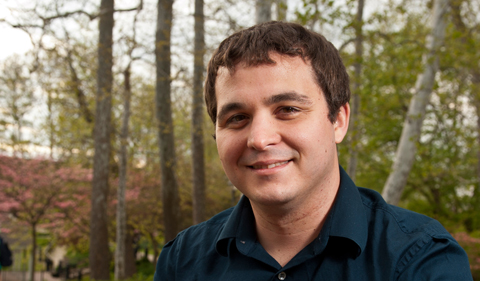By Raymond Humienny
NQPI writing intern
Ohio University Nanoscale and Quantum Phenomena Institute alumnus Greg Petersen visited the Athens campus recently for the Condensed Matter and Surface Science Colloquium as a part of the “Bring Back OUr Alumni” event.
Petersen, an algorithm engineer, shared his thoughts about establishing a career after completing a Ph.D. in physics as well as his research at TSI Inc.
Petersen graduated in May 2013 with a Ph.D. in condensed matter and materials physics from the College of Arts & Sciences. He studied under the direction of Physics & Astronomy professor Dr. Nancy Sandler.
After studying spin-orbit fields in graphene using a variety of simulation techniques, Petersen applied to become an algorithm engineer at several companies before landing a position with TSI Inc., a producer of precision measurement instrumentation. Petersen said the constant discovery found in empirical research never dulled for him after obtaining his Ph.D.
“Any time there was a mystery, it consumed you; you wanted to know why is this happening,” Petersen said. “I think it’s been a part of my success in industry: being able to test preconceived notions and address problems ahead of time.”
Algorithm engineering involves the development of two parts of a piece of software or hardware: the front-end, or the user interface of a device; and the back-end, also known as the “behind-the-scenes” calculations within the device that are not visible to the user. A common rule of thumb for these two ends is that users can interact and manipulate front-end components, while the back-end usually refers to code that is held on a virtual platform, or a server.
While Petersen has worked with both front- and back-end systems as a result of his education, he primarily works in engineering the back-end for measurement devices that detect element concentration in scrap metal and metal alloys. At the CMSS colloquium, Petersen spoke about his work on the “Commercialization of Laser-Induced Breakdown Spectroscopy for Rapid Elemental Analysis of Metallic Alloys.”
“If you were working in the scrapyard and you have a big piece of aluminum, if this has a lot of copper in it, it would be very valuable because copper is a pretty expensive commodity,” Petersen said. “There is a market for (scrappers) to know basically what’s in the material and then separate their scrap metal to get more money out of it.”
Early in the day, Petersen spoke with NQPI graduate students about building a career pathway. One of the most important things Petersen said students graduating can do is start reading job descriptions instead of job requirements. In fact, Petersen said he practiced this technique before initially applying for the position at TSI Inc.
“I just laughed because I completely discounted this job posting as something I couldn’t do because I didn’t recognize the buzzword (in the job requirements), not because I didn’t know the position,” Petersen said.
In closing, Petersen encouraged students to be confident in their abilities and look for positions in industry they could see themselves doing.
“Read the description to figure out if it’s something that interests you, and then if you find something that piques your interest, take some of the words from that description, feed it back into your search and see if you get more hits or more opportunities like that,” Petersen said. “You can start learning the language in industry of what’s out there for you.”
NQPI would like to thank Petersen and other alumni who have participated in the “Bring Back Our Alumni” event.




















Comments